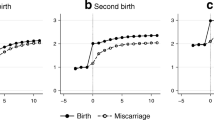Abstract
Perhaps the two most important recent strands in the economics of fertility have been developed by Becker and Easterlin. Both suggest possible biases due to unobserved variables. Becker earlier emphasized changing shadow prices for child quantity and quality and, more recently, intergenerational serially-correlated endowments, all with given preferences. Easterlin has focused on intergenerational serially-correlated preferences. Some demographers have suggested that the Becker and Easterlin approaches are converging and may not be identified from each other.
We demonstrate that while the Becker endowment and Easterlin taste models can be expressed in terms of the same variables, it is possible to identify each of the models because of different signs in a latent variable system that uses information from individuals, siblings, and cousins. Estimates of this model are consistent with the Easterlin, but not the Becker formulation. But neither model results in significant income coefficient estimates.
Similar content being viewed by others
References
Becker GS (1960) An economic analysis of fertility. In: Demographic and economic change in developed countries. Princeton University Press, Princeton, pp 209–231
Becker GS (1981) A treatise on the family. Harvard University Press, Cambridge Massachusetts London
Behrman JR, Hrubec Z, Taubman P, Wales TJ (1980) Socioeconomic success: A study of the effects of genetic endowments, family environment and schooling. North-Holland Publishing Company, Amsterdam (Contributions to Economic Analysis No. 128)
Behrman JR, Taubman P (1985) Intergenerational mobility in earnings in the U. S.: Some estimates and a test of Becker's intergenerational endowments model. Rev Econ Statist 67(1):144–151
Behrman JR, Taubman P (1989) A test of the Easterlin fertility model. Demography 26(1):117–123
Chamberlain G (1977) An instrumental variable interpretation of identification in variance-components and MIMIC models. In: Taubman P (ed) Kinometrics: Determinants of socioeconomic success within and between families. North-Holland Publishing Company, Amsterdam, pp 235–254
Easterlin RA (1966) On the relation of economic factors to recent and projected population changes. Demography 3(1):131–153
Easterlin RA (1968) Population, labor force, and long swings in economic growth: The American experience. Columbia University Press, New York
Easterlin RA (1972) Relative economic status and the American fertility swing. In: Shledon EB (ed) Family economic behavior: Problems and prospects. J. B. Lippincott Co., Philadelphia
Easterlin RA (1975) An economic framework for fertility analysis. Stud Fam Plan 6(3):54–63
Easterlin RA, Pollak RA, Wachter M (1980) Towards a more general economic model of fertility determination: Endogenous preferences and natural fertility. In: Easterlin RA (ed) Population and economic change in developing countries. University of Chicago Press for NBER, Chicago, pp 81–149
Goldberger AS (1974) Unobservable variables in econometrics. In: Zarembka P (ed) Frontiers in econometrics. Academic Prss, New York, pp 193–214
Hernandez-Iglesias F, Riboud M (1988) Intergenerational effects on fertility behavior and earnings mobility in Spain. Rev Econ Statist 70(2):253–258
Sanderson W (1980) Comment on `Toward a more general economic model of fertility determination: Endogenous preferences and natural fertility. In: Easterlin RA (ed) Population and economic change in developing countries. University of Chicago Press for NBER, Chicago, pp 140–144
Wahl JB (1980) Fertility in America: Historical patterns and wealth effects on the quantity and quality of children. PhD. Dissertation, University of Chicago
Author information
Authors and Affiliations
Additional information
The authors thank NIH for research support and Alan Mathios for excellent research assistance. The usual disclaimer applies.
Rights and permissions
About this article
Cite this article
Behrman, J.R., Taubman, P. A comparison and latent variable test of two fertile ideas. J Popul Econ 3, 19–30 (1990). https://doi.org/10.1007/BF00160415
Received:
Accepted:
Issue Date:
DOI: https://doi.org/10.1007/BF00160415




